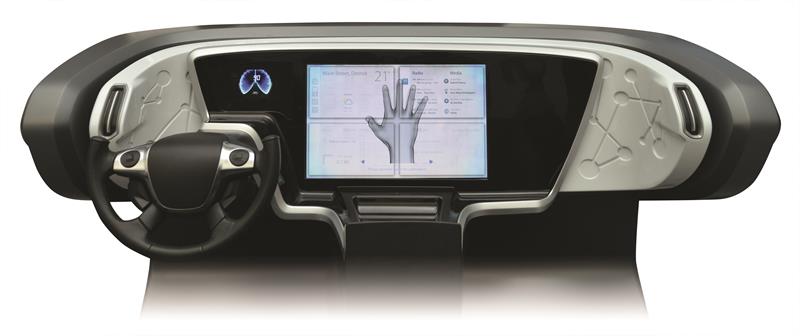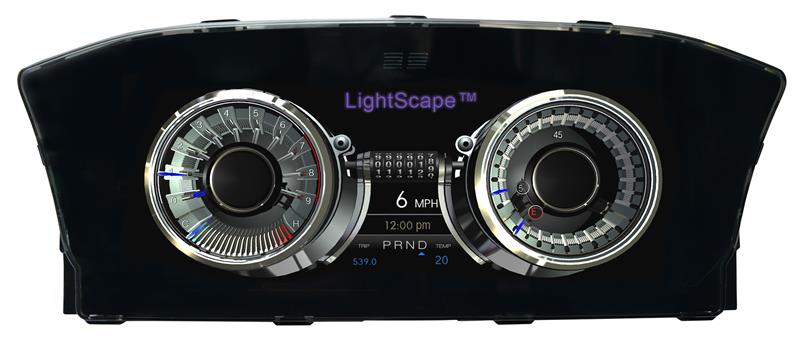But it’s not just drivers who are focused on information displays; car manufacturers are moving quickly to update the traditional dashboard display to incorporate some of the features available from driver assistance systems (ADAS).
Jeff Schroeder, portfolio manager with cockpit electronics specialist Visteon, pointed to a rapid shift to the use of high end technology. “The reconfigurable cluster sector in dollar terms is growing at a CAGR of 32% in the next five years. Other segments, such as hybrid clusters, are growing at more like 2 to 3% a year.”
Although something of a recent development, the first commercial application of reconfigurable displays came at JLR in 2009. Gary Waller, senior manager of business development with Visteon, noted: “Over the last decade, there has been a trend towards the use of colour TFT technology and larger displays. It’s a trend seen in all market segments, not just the premium end.”
But recently, there has been wide acceptance of displays replacing dials. “One of the key things,” Waller continued, “is not only market acceptance, but also quality and cost.”
Damon Grigg, technical sales manager, added: “Looking back, it’s quite interesting. When we were working on the first product, we were concerned about it being accepted.”
Waller: “We believed it was a sector that would take off, but we didn’t know when. We had to develop a vision of how the market would move.”
And the market has developed to encompass large colour displays and, more recently, the appearance of 3D graphics. Waller continued: “The real requirement is for larger displays. While the 3 to 5in display is big in the consumer world, things like ADAS need more information to be given to the driver. The cluster is one of the best locations; better than the centre stack and better than using a head up display.”
 Visteon's Horizon concept uses an advanced camera system to allow drivers to interact with their vehicle via gestures and to interact with virtual buttons and knobs.
Visteon's Horizon concept uses an advanced camera system to allow drivers to interact with their vehicle via gestures and to interact with virtual buttons and knobs.
Grigg said that, only a couple of years ago, most clusters featured small segmented displays. “But vehicles today are more complicated and so there is the need for a better way to indicate faults and to show information in a more convenient and logical way.”
Visteon is now pushing towards the use of 12.3in TFT displays. “That’s probably the largest screen you can get into a cluster package,” Waller commented. “Where they were running at about 150,000 a year, today it’s more than 500,000 and heading towards 1million a year. And these displays are providing higher resolutions.”
Now that companies such as Visteon have displays with sufficient resolution to meet the application’s needs, the focus has moved to the quality of the graphics being displayed. “Rather than continuing to focus on pixel quantity,” Waller explained, “we are now looking at technologies which will improve display quality, including such parameters as colour gamut.”
Although TFTs meet current needs and different coatings have been developed to cope with factors such as reflections, the focus is now on the use of OLEDs to enable thinner borders around the display, as well as different shapes.
However, cluster design isn’t a simple process. Waller noted: It’s difficult, because it all comes down to the manufacturer’s brand and styling requirements.”
But behind the instrument cluster is a graphic processor – and the module is typically one of the most powerful such devices in the vehicle. “It comes down to the drive electronics,” Grigg said. “Processors that are not only powerful enough to drive the content, but which are also more cost effective and capable of working in an automotive environment.
“As graphics processors become more powerful, we can use them to get a lot of rendered effects and deploy them quickly. This has allowed us to move from 2D to 3D graphics and to employ such things as lighting effects.”
 Visteon's LightScape instrument clusters feature reconfigurable high resolution colour displays supporting complex 3D graphics, camera inputs and video features for driver awareness
Visteon's LightScape instrument clusters feature reconfigurable high resolution colour displays supporting complex 3D graphics, camera inputs and video features for driver awareness
Visteon is not tied to a particular graphics processor supplier. “We’re agnostic,” Waller pointed out, “and work with multiple partners. We’re looking for the right solution for the application. While Visteon is known for graphics, this is about adding to the package.”
Factors which affect these decisions include RAM bandwidth. Grigg said: “We’re now looking at using LPDDR4 memory to provide enough data bandwidth to feed the GPU.”
Processors deployed in instrument clusters are typically running at 150MHz, with a DDR4 bandwidth of the order of 57Gbyte/s. “In some cases,” Grigg said, “we’re using GPUs with 10 cores. But because we can’t keep pushing the clock speed up, we’re now looking at such things as frame buffer compression because data bandwidth isn’t keeping up with how quickly the cluster consumes data. The display typically refreshes at 60Hz, so we need to feed updates at that rate.”
Bigger displays with more information can bring problems, however. “Driver distraction is an issue,” Grigg admitted, “so cluster development is also about workload management; only showing information when it’s appropriate and when the driver is ready to see it.”
Already, clusters are being developed which integrate navigation and infotainment functionality. Future developments could include placing cameras in the cluster to support eye tracking. This would not only help the system to provide contextual information, but also monitor the driver’s state.
Underlying all cluster developments is the auto industry’s close attention to cost. “There’s a lot more cost pressure at the non premium end of the market and our task is to find the right balance for the application,” Grigg concluded.
The light fantastic
Car headlights, it seems, have developed a mind of their own. Not long ago, it was a matter of full or dipped beams and fog lights if you really wanted to push the boat out. Not any more. Today’s state of the art lighting can point out potential hazards in the road ahead; tomorrow’s offerings might even be able to have a limited conversation with you. Stephan Berlitz, head of lighting functions and innovation with Audi, said: “Car lighting was essentially the same for 100 years, with the driver switching manually between high and low beams.” But he noted that times are changing. “The first step in developing intelligent lighting was to use a forward looking camera to recognise things and switch between high and low beam automatically. Now, with matrix lights, it’s possible to turn off particular areas; for example, an oncoming car. It’s a win-win,” he continued, “you can always drive on high beam and see as much of the road ahead as possible.” The move to embedding more intelligence in headlights has been underway for about 15 years. “We have always wanted to create perfect lighting,” Berlitz said. “Now, all the things we need to create such a system are available, so we can now think about what’s possible and what we need to do to bring such a system to a car.” Audi’s most sophisticated headlamp arrangement is the Matrix LED unit, which provides maximum illumination of the road by maintaining a constant high beam without dazzling other road users. The electronic unit has no mechanical parts; instead, LEDs can be lit or dimmed individually, diverting their beam around traffic. But there are other applications beyond avoid dazzling other drivers, including highlighting potential danger ahead and avoiding too much reflected glare from roadsigns. “It can help drivers in road works, for example, where there are narrow lanes,” Berlitz said. “The headlights could project a beam which is the width of the car to show whether or not there’s enough room. It helps drivers to feel safer.” The next step will be Matrix laser headlights, which will take advantage of digital micromirror technology. While today’s intelligent lights have 25 segments, tomorrow’s versions may have 400,000 segments in each light, with each mirror able to move at rates of up to 5kHz, enabling entirely new features. One such idea is car-to-pedestrian communications. “If a car is approaching,” Berlitz said, “the pedestrian might wonder if it’s safe to cross the road. Intelligent lighting systems can project a message in front of them to say whether to cross or wait.” Intelligent lighting relies on input from a front facing camera. “Normal cameras are fast enough,” Berlitz said, “but the big problem is differentiating between oncoming cars and those in front. You need a field of view of more than ±20° because you need to see road signs and so on. And it needs to be able to recognise lights at night. Stereo cameras would be better, but we have found other ways to do this.” Headlighting systems currently use relatively simple controls, but those with micro mirrors will need to be operated using complex video signals. “That’s going to need a completely new architecture,” Berlitz pointed out, “in which you can create, calculate and send video to the headlights.” Also on the road map are headlights that tie into the vehicle’s navigation system, so the light ‘turns into’ bends as the car approaches and which highlight features such as crossroads. “And these systems will automatically change the light distribution for driving in the UK and Europe,” Berlitz concluded. |











